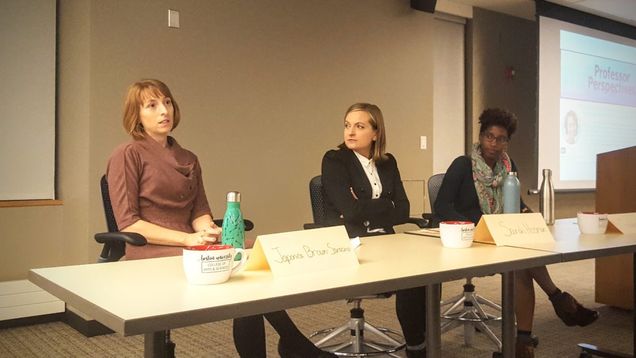Professor Perspectives: Gentrification in Boston: Are You a Gentrifier?
On October 25th, Sociology Professor Japonica Brown-Saracino and PhD candidates Taylor Cain and Sarah Hosman discussed gentrification in Boston through a historical lens and through specific case studies in Allston, Jamaica Plain, and Roxbury.

Professor Japonica Brown-Saracino took the audience through the origins of gentrification; Ruth Glass coined the term in 1964 when she noticed the social character of a district was changing and the working class was moving out. Through her research, Brown-Saracino identified three types of gentrifiers who differ by their origins, visions, and attitudes of the neighborhood: social preservationists, social homesteaders, and pioneers. She highlighted that gentrification is ubiquitious in Boston; between 1999 and 2015, the median home value skyrocketed from $210,000 to $453,000. Brown-Saracino emphasized that “if we truly had robust housing policy, we wouldn’t have to worry about this.”
Taylor Cain, a PhD candidate and 2017 Summer Fellow with the Initiative on Cities, discussed commercial gentrification within Jamaica Plain and Roxbury. The arrival of new consumption spaces mostly appeals to the upper class, while kicking out the lower class. High-priced boutiques are often displacing smaller mom-and-pop shops. In Jamaica Plan, controversy stirred when the Latino grocery store Hi-Lo was replaced with a Whole Foods. Through interviews with residents, Cain concluded that gentrifiers often feel torn about shopping at new businesses but continue to support the stores nevertheless. Meanwhile, longtime business owners feel anxiety about adapting to new customers and surviving in a “community that has slowly been dismantled over time.”
Sarah Hosman, a PhD candidate in Sociology, looked at the different generations of gentrifiers in Allston. The “Brooklynization” of Allston came in stages: early pioneers relocated for its cultural value, thus spurring more pioneers and media attention, and finally resulting in widespread reinvestment and displacement. Pioneers view themselves as saviors who serve previously unmet needs in the neighborhood. Through her research, Hosman interviewed a gentrifier who proudly bragged “I got rid of some of the homeless people. I cleaned it up so it got more respectable.” She also noted how diversity often attracts gentrifiers; between 1970 to 2010, Allston’s white population dropped from 90% to 56%.
Attendees were eager to join the discussion surrounding political pressures on local councilmen to mitigate impacts of gentrification, and colleges’ influence on neighborhood diversity. Panelists also discussed the influence of large companies in Boston, especially now after Boston has submitted multiple bids for Amazon’s second headquarters.
Brown-Saracino, Cain and Hosman have all received Early Stage Urban Research Awards from the Initiative on Cities. Learn more about their related work on gentrification and community identity here.